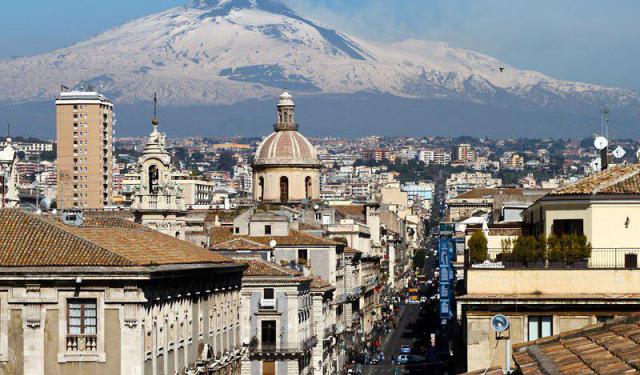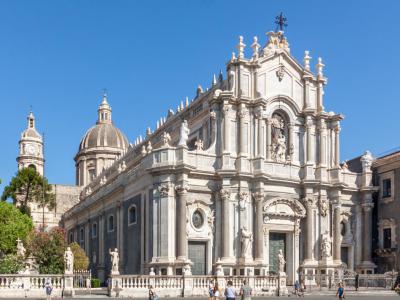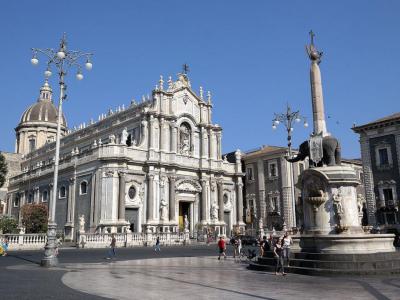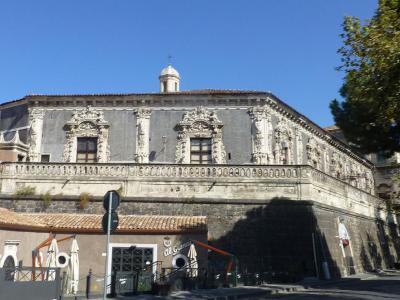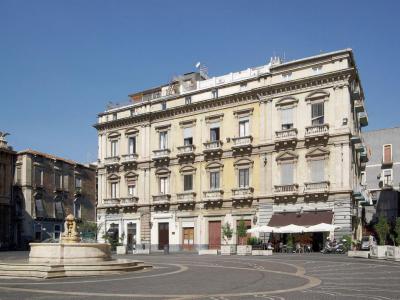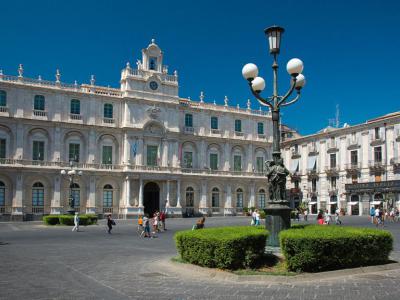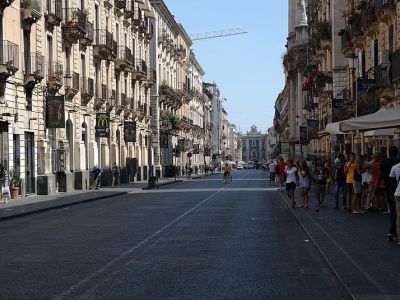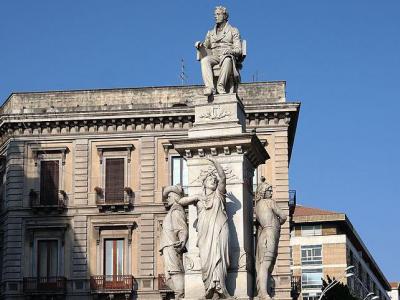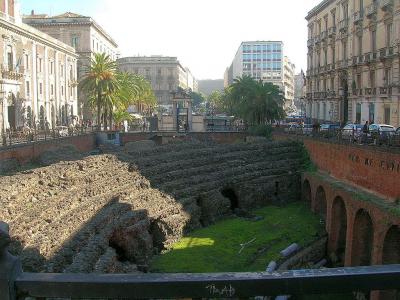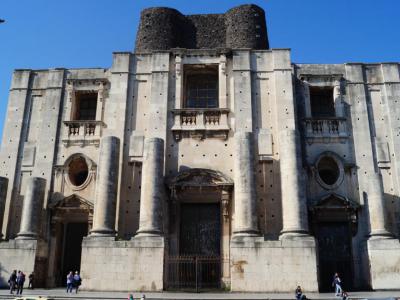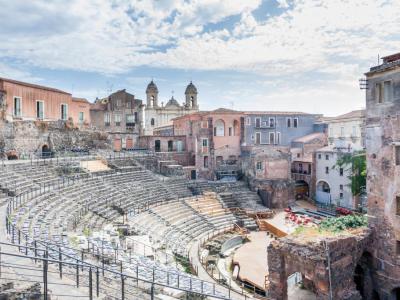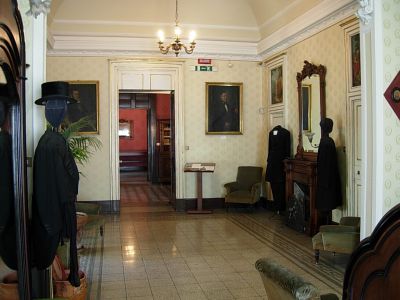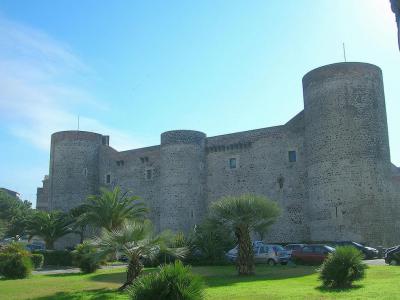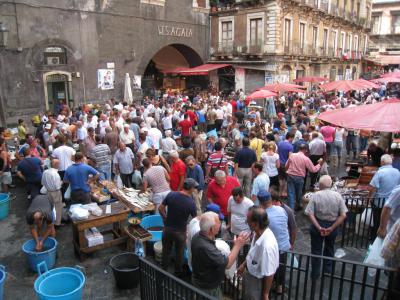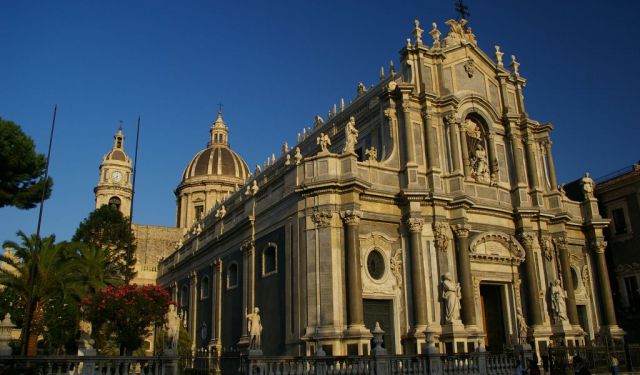Catania Introduction Walking Tour (Self Guided), Catania
The old Sicilian word "katane" is often translated as "harsh ground" or "sharp stones." Black lava from Mount Etna has swamped the area many times. Other disasters include earthquakes, invasions and wars.
The original village of Katane was occupied by Greek settlers in the eighth century BC. During the first Punic War, Catania became a Roman city. The Vandals called in 440, followed by Ostrogoths, Byzantines, Arabs and Normans.
In 1669 Mount Etna erupted and threatened to bury everything. The city escaped thanks to its walls. However, in 1693 a massive earthquake did indeed destroy Catania. The city was completely rebuilt in the Baroque style that it has retained to this day.
Start in the main square, the Piazza del Duomo. Facing the square is the Cathedral of Saint Agatha. Rebuilt after the earthquake of 1693, it is a masterpiece of Baroque architecture. It houses the tomb of composer Vincenzo Bellini, a native son. Saint Agatha is a martyr and the patroness of Catania.
In the middle of the square is Liotru, also known as the Fountain of the Elephant. It was put together in 1736 by Giovanni Battista Vaccarini. It is a black lava elephant holding an obelisk on his back. The elephant is the traditional totem of the city.
Walk along the via dei Crociferi. It is located between the ancient Roman Theater and the Bellini Gardens. Baroque churches of San Francesco Borgia, San Benedetto, Saint Francis of Assisi and Santa Giuliana line the street.
The 13th century Castle Ursino is home to the Civic Museum. The Biscari Palace is an ornate Baroque palace rebuilt in 1693. A residence of the Biscari family, the palace is also host to tours, cultural events and conferences.
Close by Catania Cathedral is the Fish Market. It is the busiest and oldest market in Sicily. It wanders through squares and streets. It is lively and spirited. Here is the bumptious soul of Catania, as it has always been.
The original village of Katane was occupied by Greek settlers in the eighth century BC. During the first Punic War, Catania became a Roman city. The Vandals called in 440, followed by Ostrogoths, Byzantines, Arabs and Normans.
In 1669 Mount Etna erupted and threatened to bury everything. The city escaped thanks to its walls. However, in 1693 a massive earthquake did indeed destroy Catania. The city was completely rebuilt in the Baroque style that it has retained to this day.
Start in the main square, the Piazza del Duomo. Facing the square is the Cathedral of Saint Agatha. Rebuilt after the earthquake of 1693, it is a masterpiece of Baroque architecture. It houses the tomb of composer Vincenzo Bellini, a native son. Saint Agatha is a martyr and the patroness of Catania.
In the middle of the square is Liotru, also known as the Fountain of the Elephant. It was put together in 1736 by Giovanni Battista Vaccarini. It is a black lava elephant holding an obelisk on his back. The elephant is the traditional totem of the city.
Walk along the via dei Crociferi. It is located between the ancient Roman Theater and the Bellini Gardens. Baroque churches of San Francesco Borgia, San Benedetto, Saint Francis of Assisi and Santa Giuliana line the street.
The 13th century Castle Ursino is home to the Civic Museum. The Biscari Palace is an ornate Baroque palace rebuilt in 1693. A residence of the Biscari family, the palace is also host to tours, cultural events and conferences.
Close by Catania Cathedral is the Fish Market. It is the busiest and oldest market in Sicily. It wanders through squares and streets. It is lively and spirited. Here is the bumptious soul of Catania, as it has always been.
How it works: Download the app "GPSmyCity: Walks in 1K+ Cities" from Apple App Store or Google Play Store to your mobile phone or tablet. The app turns your mobile device into a personal tour guide and its built-in GPS navigation functions guide you from one tour stop to next. The app works offline, so no data plan is needed when traveling abroad.
Catania Introduction Walking Tour Map
Guide Name: Catania Introduction Walking Tour
Guide Location: Italy » Catania (See other walking tours in Catania)
Guide Type: Self-guided Walking Tour (Sightseeing)
# of Attractions: 13
Tour Duration: 2 Hour(s)
Travel Distance: 3.8 Km or 2.4 Miles
Author: vickyc
Sight(s) Featured in This Guide:
Guide Location: Italy » Catania (See other walking tours in Catania)
Guide Type: Self-guided Walking Tour (Sightseeing)
# of Attractions: 13
Tour Duration: 2 Hour(s)
Travel Distance: 3.8 Km or 2.4 Miles
Author: vickyc
Sight(s) Featured in This Guide:
- Cathedral of Catania
- Piazza Duomo (Cathedral Square)
- Palazzo Biscari (Biscari Palace)
- Piazza Bellini (Bellini Square)
- Piazza dell'Universita (University Square)
- Via Etnea (Etnea Street)
- Monument to Vincenzo Bellini
- Roman Amphitheater
- Monastery of St. Nicholas Arena
- Roman Theater of Catania
- Giovanni Verga House Museum
- Museo Civico (Civic Museum)
- At 'Piscaria (Catania Fish Market)
1) Cathedral of Catania (must see)
Agatha was a pious virgin from a noble Catania family in 231 AD. The Roman prefect Quintianus made amorous moves on her. She rebuffed him. He martyred her. But things went bad for Quintianus. His horse kicked him in the river. He hasn't been seen since.
The Cathedral of Catania, also known as Cathedral of Saint Agatha, stands in the Cathedral Square (Piazza del Duomo). It is built in Italian Baroque style. The facade was fashioned in 1700 after a devastating earthquake in 1693. It has three levels with niches and columns of Corinthian granite.
The main entrance has a carved wooden door showing 32 plaques of the life of the Saint. The dome was created in 1802. The bell tower is a rebuilt. A parvis with a white stone balustrade harbors five statues of saints in Carrara marble.
The interior has a Latin Cross plan and three naves. The apse dates from the 12th century. In the north transept is the Chapel of the Holy Crucifix. The cathedral holds the tombs of Vincenzo Bellini, the great Italian composer, and King Frederick III, John of Randazzo and Constance of Aragon.
They say Saint Agatha protects Sicily against enemies, corrupt officials and even Mount Etna. Carved into the facade of the cathedral are the letters N.O.P.A.Q.V.I.E. which are the initial letters of each word in a sentence in Latin that says "Agatha will revenge any injustice perpetrated by those who offend her land".
A promise that has been kept for 1,800 years.
The Cathedral of Catania, also known as Cathedral of Saint Agatha, stands in the Cathedral Square (Piazza del Duomo). It is built in Italian Baroque style. The facade was fashioned in 1700 after a devastating earthquake in 1693. It has three levels with niches and columns of Corinthian granite.
The main entrance has a carved wooden door showing 32 plaques of the life of the Saint. The dome was created in 1802. The bell tower is a rebuilt. A parvis with a white stone balustrade harbors five statues of saints in Carrara marble.
The interior has a Latin Cross plan and three naves. The apse dates from the 12th century. In the north transept is the Chapel of the Holy Crucifix. The cathedral holds the tombs of Vincenzo Bellini, the great Italian composer, and King Frederick III, John of Randazzo and Constance of Aragon.
They say Saint Agatha protects Sicily against enemies, corrupt officials and even Mount Etna. Carved into the facade of the cathedral are the letters N.O.P.A.Q.V.I.E. which are the initial letters of each word in a sentence in Latin that says "Agatha will revenge any injustice perpetrated by those who offend her land".
A promise that has been kept for 1,800 years.
2) Piazza Duomo (Cathedral Square) (must see)
In the Cathedral Square there is a black lava elephant with an obelisk on his back. It is thought of as the symbol of Catania even if the inference is obscure. The elephant was brought here with his obelisk by Giovanni Battista Vaccarini. Giovanni was the architect charged with restoring the Square after the earthquake of 1693.
The Cathedral Square is the busy center of Catania. The Baroque square and the buildings around it are the restorations of architect Vaccarini, They are Uzeda Gate, from 1696, The great Cathedral, 1739, the Church of Saint Agatha, 1767, the Town Hall Building, 1741 and our friend, the Elephant, 1736. Altogether a stunning achievement.
Three streets connect to the square. First is Etnea Street. This is the cardo maximus, the north-south axis of the Ancient Roman City. Next is the Giuseppe Garibaldi Street, named for the great Italian patriot. Lastly we have the Vittorio Emanuele II Street, crossing the city from east to west.
The Town Hall Building, is on the north side of the square, facing the lava elephant of Vaccarini. On the opposite side the the Palace of the Clerics faces the Amenano fountain. The fountain is fed by the underground Amenano River.
The Festival of Saint Agatha is a three day celebration that starts on February 3 of each year. It involves a procession called "della luminaria", followed by a concert and fireworks.
The Cathedral Square is the busy center of Catania. The Baroque square and the buildings around it are the restorations of architect Vaccarini, They are Uzeda Gate, from 1696, The great Cathedral, 1739, the Church of Saint Agatha, 1767, the Town Hall Building, 1741 and our friend, the Elephant, 1736. Altogether a stunning achievement.
Three streets connect to the square. First is Etnea Street. This is the cardo maximus, the north-south axis of the Ancient Roman City. Next is the Giuseppe Garibaldi Street, named for the great Italian patriot. Lastly we have the Vittorio Emanuele II Street, crossing the city from east to west.
The Town Hall Building, is on the north side of the square, facing the lava elephant of Vaccarini. On the opposite side the the Palace of the Clerics faces the Amenano fountain. The fountain is fed by the underground Amenano River.
The Festival of Saint Agatha is a three day celebration that starts on February 3 of each year. It involves a procession called "della luminaria", followed by a concert and fireworks.
3) Palazzo Biscari (Biscari Palace) (must see)
After the devastating earthquake of 1693, Ignazio Paterno Castello, 3rd prince of Biscari, felt the need to build his palace. Construction began in 1702. In 1763 the project was completed by the fifth prince of Biscari. The grand opening was marked by extravagant celebrations.
The palace is on the Museo Biscari Street in Catania. Although some members of the family Biscari still reside there, the palace is open to guided tours and cultural events. The facade on the Biscari Palace is in mild disrepair. The visitors entrance is a stone portal. It is adorned with cartouches and the coat of arms of Biscari.
After the the main entrance is a large courtyard with an outdoor entrance staircase. The interior of the palace is Rococo. There are frescoes and decorations in stucco. In the great octagonal ballroom there are mirrors, frescoes and stucco decorations painted by Matteo Desiderato and Sebastian Lo Monaco. A dome balcony can hold an orchestra.
The rooms are large and they have names. The "Fief Room" has large paintings of Biscari feudal fiefdoms. The "Princess Apartment", made for the wife of Ignazio V, is paved with salvaged Roman marble. There is a "Birds Gallery" and a "Don Quixote Room". There is the aforementioned ballroom and a museum for the collections of Ignazio V.
The palace is on the Museo Biscari Street in Catania. Although some members of the family Biscari still reside there, the palace is open to guided tours and cultural events. The facade on the Biscari Palace is in mild disrepair. The visitors entrance is a stone portal. It is adorned with cartouches and the coat of arms of Biscari.
After the the main entrance is a large courtyard with an outdoor entrance staircase. The interior of the palace is Rococo. There are frescoes and decorations in stucco. In the great octagonal ballroom there are mirrors, frescoes and stucco decorations painted by Matteo Desiderato and Sebastian Lo Monaco. A dome balcony can hold an orchestra.
The rooms are large and they have names. The "Fief Room" has large paintings of Biscari feudal fiefdoms. The "Princess Apartment", made for the wife of Ignazio V, is paved with salvaged Roman marble. There is a "Birds Gallery" and a "Don Quixote Room". There is the aforementioned ballroom and a museum for the collections of Ignazio V.
4) Piazza Bellini (Bellini Square)
Close by the Church of the Saint Agatha, in the center of Catania, is Bellini Square. It is in the form of a great circle paved with white and grey stones laid down in overlapping concentric arcs. At the edge of the widest circle of tiles, across from the Massimo Bellini Theater, are benches, plantings and trees.
In the center of the square is the 18th century Fountain of the Dolphins, designed by architect Giovanni Battista Vacarrini. The Massimo Bellini Theatre is the gem of the square, a neo-Baroque theater dedicated to the world famous composer, Vincenzo Bellini. The theater was designed by architects Andrea Scala and Carlo Sala.
The Massimo Bellini Theatre is an opera house. It opened in May 1890 with the world premier of the opera Norma, by Catania composer, Vincenzo Bellini. The Sicilian Baroque style of the Opera house blends well with the other buildings on the square.
During the day the square is a great place to find peace in the shade of the trees, away from the madding, crowded Cathedral Square. In the Bellini Square liveliness comes at night.
In the center of the square is the 18th century Fountain of the Dolphins, designed by architect Giovanni Battista Vacarrini. The Massimo Bellini Theatre is the gem of the square, a neo-Baroque theater dedicated to the world famous composer, Vincenzo Bellini. The theater was designed by architects Andrea Scala and Carlo Sala.
The Massimo Bellini Theatre is an opera house. It opened in May 1890 with the world premier of the opera Norma, by Catania composer, Vincenzo Bellini. The Sicilian Baroque style of the Opera house blends well with the other buildings on the square.
During the day the square is a great place to find peace in the shade of the trees, away from the madding, crowded Cathedral Square. In the Bellini Square liveliness comes at night.
5) Piazza dell'Universita (University Square)
Close to the Cathedral and Bellini squares in the center of Catania, is the University Square. Late Baroque palaces of the University of Catania line the square.
There is the University Palace, Gioeni Asmundo Palace and the San Giuliano Palace. The alternate name for the square is Student Square. In former times the square featured a statue by Antonio Cali of King Francis I of the Kingdom of the Two Sicilies. King Francis abdicated in 1830 and the statue followed.
The square now has four elaborate lampposts sculpted in bronze and designed by Vincenzo Corsaro. The lampposts together form a candelabra. Each candle has figures at the base that tell a tale of Sicily. In the telling, the statues celebrate virtues traditionally esteemed in Sicily: Chastity; Patriotism; Filial Devotion, and; Cleverness.
The lamp-post Gemmazita shows a woman dives into a well to avoid a lustful French soldier. This event is said to the cause of the War of Sicilian Vespers which was a successful rebellion on the island of Sicily that broke out at Easter 1282 against the rule of the French-born king Charles I.
The lamp-post Paladin shows a knight of Catalan defeats a Saracen and marries a princess.
The lamp-post Fratelli Pi shows two brothers save their elders from a river of lava by carrying them on their shoulders (the brothers' shoulders).
The lamp-post Colapesce (Tail-Fish) shows Count Ruggero asks a very young merman if he can see Mount Etna underwater. The boy says yes. He dives holding a log. He is not seen again but the volcano spits out the log during an eruption.
There is the University Palace, Gioeni Asmundo Palace and the San Giuliano Palace. The alternate name for the square is Student Square. In former times the square featured a statue by Antonio Cali of King Francis I of the Kingdom of the Two Sicilies. King Francis abdicated in 1830 and the statue followed.
The square now has four elaborate lampposts sculpted in bronze and designed by Vincenzo Corsaro. The lampposts together form a candelabra. Each candle has figures at the base that tell a tale of Sicily. In the telling, the statues celebrate virtues traditionally esteemed in Sicily: Chastity; Patriotism; Filial Devotion, and; Cleverness.
The lamp-post Gemmazita shows a woman dives into a well to avoid a lustful French soldier. This event is said to the cause of the War of Sicilian Vespers which was a successful rebellion on the island of Sicily that broke out at Easter 1282 against the rule of the French-born king Charles I.
The lamp-post Paladin shows a knight of Catalan defeats a Saracen and marries a princess.
The lamp-post Fratelli Pi shows two brothers save their elders from a river of lava by carrying them on their shoulders (the brothers' shoulders).
The lamp-post Colapesce (Tail-Fish) shows Count Ruggero asks a very young merman if he can see Mount Etna underwater. The boy says yes. He dives holding a log. He is not seen again but the volcano spits out the log during an eruption.
6) Via Etnea (Etnea Street)
Etnea Street is Catania's main Street. It extends three miles from the Cathedral Square all the way to the park Tondo Gioeni at the edge of town. The street dates from Roman times but the current Etnea Street came about after the earthquake of 1693.
The buildings along the route were mostly leveled in the earthquake. They were replaced with Baroque style buildings designed by Giovanni Battista Vaccarini and Francesco Battaglia. The street today is pedestrianized to a large extent. The sidewalks are made wholly of lava stone, courtesy of Mount Etna.
Among the buildings along the road is the palace of Gioeni Asmundo in the University square. The San Demetrio Palace and Toscano Palace are both in the Stesicore Square with the Vincenzo Bellini monument. The Post Office Building still serves as a post office. Last is the Villa Bellini, the garden of Catania.
Etnea Street is also shopping street. As you walk along you notice the ground floors of these fine Baroque buildings are shops. The shops seem to alternate among restaurants, cafes and bars. A lot of tasting goes on here. Pasta alla Norma, arancini and cannoli and many other traditional dishes await the hungry stroller.
The buildings along the route were mostly leveled in the earthquake. They were replaced with Baroque style buildings designed by Giovanni Battista Vaccarini and Francesco Battaglia. The street today is pedestrianized to a large extent. The sidewalks are made wholly of lava stone, courtesy of Mount Etna.
Among the buildings along the road is the palace of Gioeni Asmundo in the University square. The San Demetrio Palace and Toscano Palace are both in the Stesicore Square with the Vincenzo Bellini monument. The Post Office Building still serves as a post office. Last is the Villa Bellini, the garden of Catania.
Etnea Street is also shopping street. As you walk along you notice the ground floors of these fine Baroque buildings are shops. The shops seem to alternate among restaurants, cafes and bars. A lot of tasting goes on here. Pasta alla Norma, arancini and cannoli and many other traditional dishes await the hungry stroller.
7) Monument to Vincenzo Bellini
Doh, re, mi, fa, so, la, ti; seven notes, seven steps up the pyramid monument to Vincenzo Bellini. Atop a column atop the pyramid Vincenzo sits. He's like a professor. With a manuscript on his knee he sits and ponders the Church of Saint Agatha at Fornace. He venerated her all his short life. He died at 34 in 1835.
The monument was designed and sculpted by Giulio Monteverde. It was unveiled in September 1882. Some say the monument should have been in the Bellini Square, across from the not yet finished Massimo Bellini Theatre. Others wished they would replace the elephant with the composer in the Cathedral Square. But no, he is with his saint.
Below the composer, around the pyramid are four statues representing four of his operas: Norma, I Puritani (The Puritans), La Sonnambula (The Sleepwalker) and Il Pirata (the Pirate). The entire monument is enclosed in an iron art nouveau fence.
The monument was designed and sculpted by Giulio Monteverde. It was unveiled in September 1882. Some say the monument should have been in the Bellini Square, across from the not yet finished Massimo Bellini Theatre. Others wished they would replace the elephant with the composer in the Cathedral Square. But no, he is with his saint.
Below the composer, around the pyramid are four statues representing four of his operas: Norma, I Puritani (The Puritans), La Sonnambula (The Sleepwalker) and Il Pirata (the Pirate). The entire monument is enclosed in an iron art nouveau fence.
8) Roman Amphitheater
There is the Coloseum, the Ampithraetre of Capua, and the Verona Arena. They are in the groups of the largest arenas. The amphitheater of Catania, eroded, dismantled and mostly buried is also among that group. The amphitheater of Catania was built around 200 AD. It lies below the slopes of Montevergine Hill on the northern side of town.
Only a piece of it can be seen. It is close to the Stesorico Square. It is a part of the exhibit of the Greek-Roman Archaeological Park of Catania. It was an elliptical arena with radial walls and vaults to support the seats.
A gallery with a facade encircled the exterior. The ellipse of the arena had a large diameter of 268 feet. The small diameter was 164 feet. The outside diameters were 478 feet and 345 feet. The outside circumference was 1,015 feet. A respectable size overall. The materials used in the walls show some degree of recycling.
Seating capacity was about 15,000. More could have been accommodated by adding standing room only bleachers of wood. The theatre was able to stage sea battles, making use of the city's aqueduct. An iron gate is presently used for access. Two ionic columns flank the gate and support an architrave with the inscription, "Ampitheatrum Insigne".
Legend has it that the theatre was spared burial by lava in the eruption of Mount Etna in 251. It was in that year Saint Agatha died. Her spiritual intervention might have saved many. However, the lava stopped before reaching Catania. There is no evidence she favored sports arenas, but then she did favor Catania.
In 1693 the arena was buried by the earthquake of that year. Giovanni Gioeni used rubble to build homes and a neo-classical facade for the Church of San Biagio. The ground that buried the amphitheater was used as a garden. The amphitheater of Catania had just disappeared. It reappeared in excavations of the 1700s.
Only a tenth of the amphitheater is visible today.
Only a piece of it can be seen. It is close to the Stesorico Square. It is a part of the exhibit of the Greek-Roman Archaeological Park of Catania. It was an elliptical arena with radial walls and vaults to support the seats.
A gallery with a facade encircled the exterior. The ellipse of the arena had a large diameter of 268 feet. The small diameter was 164 feet. The outside diameters were 478 feet and 345 feet. The outside circumference was 1,015 feet. A respectable size overall. The materials used in the walls show some degree of recycling.
Seating capacity was about 15,000. More could have been accommodated by adding standing room only bleachers of wood. The theatre was able to stage sea battles, making use of the city's aqueduct. An iron gate is presently used for access. Two ionic columns flank the gate and support an architrave with the inscription, "Ampitheatrum Insigne".
Legend has it that the theatre was spared burial by lava in the eruption of Mount Etna in 251. It was in that year Saint Agatha died. Her spiritual intervention might have saved many. However, the lava stopped before reaching Catania. There is no evidence she favored sports arenas, but then she did favor Catania.
In 1693 the arena was buried by the earthquake of that year. Giovanni Gioeni used rubble to build homes and a neo-classical facade for the Church of San Biagio. The ground that buried the amphitheater was used as a garden. The amphitheater of Catania had just disappeared. It reappeared in excavations of the 1700s.
Only a tenth of the amphitheater is visible today.
9) Monastery of St. Nicholas Arena (must see)
Formerly a Benedictine establishment, the monastery is located at Dante Square in Catania. It is part of Val di Noto Works Heritage Site. There are no monks to be found on the premises but the humanities department of the University of Catania has found a home here.
The monastery was founded in 1558 and dedicated to San Nicolo "l'Arena." The monastery is in the center of town. It stands beside the Church of San Nicolo l'Arena. After the 1669 eruption of Mount Etna and the 1693 earthquake, the monastery was level with the ground.
Rebuilding commenced in 1702 and continued until the monastery was confiscated by the government in 1866. The current monastery rests on top of the original one (what was left of it). It has a new cloister and area designed by Giovanni Battista Vaccarini.
The original monastery used a square floor plan. A cloister in the center was called the "marble" cloister. It had a marble colonnade and a clover shaped fountain with refined renaissance decorations. In 1693 all this was destroyed.
The "Marble" cloister was rebuilt with late baroque decorations. The Eastern Cloister was a new addition. A new area on the North side was also added.
Giancarlo De Carlo, architect, has said, "...the old meanings have been substituted by a new one that allows the old architecture get a new structure and an important role for the contemporary world."
The monastery was founded in 1558 and dedicated to San Nicolo "l'Arena." The monastery is in the center of town. It stands beside the Church of San Nicolo l'Arena. After the 1669 eruption of Mount Etna and the 1693 earthquake, the monastery was level with the ground.
Rebuilding commenced in 1702 and continued until the monastery was confiscated by the government in 1866. The current monastery rests on top of the original one (what was left of it). It has a new cloister and area designed by Giovanni Battista Vaccarini.
The original monastery used a square floor plan. A cloister in the center was called the "marble" cloister. It had a marble colonnade and a clover shaped fountain with refined renaissance decorations. In 1693 all this was destroyed.
The "Marble" cloister was rebuilt with late baroque decorations. The Eastern Cloister was a new addition. A new area on the North side was also added.
Giancarlo De Carlo, architect, has said, "...the old meanings have been substituted by a new one that allows the old architecture get a new structure and an important role for the contemporary world."
10) Roman Theater of Catania (must see)
The Roman Theater of Catania is actually two open air semicircular theaters. The site is bordered by San Francesco Square, Vittorio Emanuele Street and Teatro Greco Street in central Catania. The large theater and the smaller one, called the Odeon, are part of Graeco-Roman Archaeological Park of Catania.
The theater was built in the 2nd century AD. It was not completely excavated until the 19th century. Seats rise up a hillside facing the sea. The orchestra and stage have a diameter of 84 feet. The cavea (seating) section has a depth of 322 feet. Twenty-one rows of seats could hold up to 7,000 spactators. Exits were below the seats.
After the fifth century AD the theater and Odeon were no longer used. Digging on the site began in the 18th century during the rule of Ignazio Paterno Castello, the Prince of Biscari.
Finally, in 1959 the site was cleared of houses that were encroaching on the area and the theater and the Odeon were exposed. Artifacts removed from the dig are displayed nearby in the Pandolfo House and Liberti House.
The theater was built in the 2nd century AD. It was not completely excavated until the 19th century. Seats rise up a hillside facing the sea. The orchestra and stage have a diameter of 84 feet. The cavea (seating) section has a depth of 322 feet. Twenty-one rows of seats could hold up to 7,000 spactators. Exits were below the seats.
After the fifth century AD the theater and Odeon were no longer used. Digging on the site began in the 18th century during the rule of Ignazio Paterno Castello, the Prince of Biscari.
Finally, in 1959 the site was cleared of houses that were encroaching on the area and the theater and the Odeon were exposed. Artifacts removed from the dig are displayed nearby in the Pandolfo House and Liberti House.
11) Giovanni Verga House Museum
Giovanni Verga died in 1922 in the house where he was born. He had inherited the house from his mother and it stayed in the family until 1991. It had been a national monument since 1940. In 1991 it came under management by the regional government.
Giovanni Verga had become a world famous writer of short stories and novels. One of his most famous works was Cavallieria Rusticana. It was staged by Eleanora Duse in 1884. In 1890 the opera Cavalleria Rusticana premiered with a libretto by G. Targioni-Tozzetti and music by Pietro Mascagni.
There is an obscure road in the heart of Catania. It connects to Vittorio Emanuele Street and Garibaldi Street. On this road is the Verga family home and museum. After the main entrance is a staircase leading to the writer's apartment. At the entrance one is greeted by a guide who will accompany the visitor in a tour of the house.
First stop is the sitting room, furnished with display cases containing copies of some of the author's manuscripts. In one corner of the room is a bust of Giovanni by the sculptor Bruno. A wooden case holds the death mask of Giovanni's father, Giovan Battista Verga Catalano.
The really important room is the library. There is a table holding personal items. Along the walls are bookcases holding more than 2,500 books, some by Giovanni and many writings by Italian and western authors.
The other rooms are furnished soberly and tastefully. The last room is a small dining room which opens out to the main entrance. The dining room has a dumbwaiter installed. It reaches to the kitchen above. Sorry, no eating there.
Giovanni Verga had become a world famous writer of short stories and novels. One of his most famous works was Cavallieria Rusticana. It was staged by Eleanora Duse in 1884. In 1890 the opera Cavalleria Rusticana premiered with a libretto by G. Targioni-Tozzetti and music by Pietro Mascagni.
There is an obscure road in the heart of Catania. It connects to Vittorio Emanuele Street and Garibaldi Street. On this road is the Verga family home and museum. After the main entrance is a staircase leading to the writer's apartment. At the entrance one is greeted by a guide who will accompany the visitor in a tour of the house.
First stop is the sitting room, furnished with display cases containing copies of some of the author's manuscripts. In one corner of the room is a bust of Giovanni by the sculptor Bruno. A wooden case holds the death mask of Giovanni's father, Giovan Battista Verga Catalano.
The really important room is the library. There is a table holding personal items. Along the walls are bookcases holding more than 2,500 books, some by Giovanni and many writings by Italian and western authors.
The other rooms are furnished soberly and tastefully. The last room is a small dining room which opens out to the main entrance. The dining room has a dumbwaiter installed. It reaches to the kitchen above. Sorry, no eating there.
12) Museo Civico (Civic Museum)
The Biscari Museum had been closed. The Biscari collections and the collection Benedettini needed a new home. In 1934 Guido Libertini, Superintendent of Antiquities, found that home; the massive Ursino Castle. The castle was the only edifice capable of housing the Biscari and Benedettini collections and the Asmundo collection as well.
The Ursino Castle ("Bear Castle") was built in the 13th century. It was meant to be a royal castle of the Kingdom of Sicily. During the time of the Sicilian Vespers it became the home of the Sicilian Parliament. It has remained in good condition and it currently serves well as an art museum.
The castle is laid out in a rectangle. It has four circular towers at each corner and an open air courtyard. On the ground floor is the Arms Room. The Arms Room houses the ticket office and a large collection of weapons. Other rooms on the ground floor house various Greek and Roman antiquities, including statues, figurines, vases and mosaics.
The first floor (second floor in U.S.) houses 17th and 18th century masterpieces, featuring paintings by Matthias Stormer, Pietro Novelli, Caravaggio, Mario Minniti, Andrea Vaccaro and others. Some rooms on the floor are dedicated to individual artists.
The Open Space is a large room for temporary exhibitions and sculptures. A neighboring room houses numismatics and engravings.
Like the castle, the collections are vast. The Museum is a definite "must see" for art and history lovers.
The Ursino Castle ("Bear Castle") was built in the 13th century. It was meant to be a royal castle of the Kingdom of Sicily. During the time of the Sicilian Vespers it became the home of the Sicilian Parliament. It has remained in good condition and it currently serves well as an art museum.
The castle is laid out in a rectangle. It has four circular towers at each corner and an open air courtyard. On the ground floor is the Arms Room. The Arms Room houses the ticket office and a large collection of weapons. Other rooms on the ground floor house various Greek and Roman antiquities, including statues, figurines, vases and mosaics.
The first floor (second floor in U.S.) houses 17th and 18th century masterpieces, featuring paintings by Matthias Stormer, Pietro Novelli, Caravaggio, Mario Minniti, Andrea Vaccaro and others. Some rooms on the floor are dedicated to individual artists.
The Open Space is a large room for temporary exhibitions and sculptures. A neighboring room houses numismatics and engravings.
Like the castle, the collections are vast. The Museum is a definite "must see" for art and history lovers.
13) At 'Piscaria (Catania Fish Market) (must see)
A'Piscaria, is "fish market" in Sicilian. Here is the most venerable and hectic place in Catania, take a stroll through the always busy fish market of Catania. This market makes the one in Palermo look tame. The market and the stalls extend from one street to another.
So many different kinds of fish and the people are of different kinds as well. Cockles, clams, mussels, urchins, what would you like? Everything, the shouting, the smells, the colors, the humor beneath the red awnings are all a happy frenzy here.
The market has been open every day since 1800. That's a long run on Broadway. Together with the Mondays Fair it is the most exciting market in Sicily.
Only a few steps away from the Cathedral of Catania and the Palace of the Elephants, the Piscaria extends out in all directions. It sneaks into streets, hides and reappears unexpectedly. Visitors are welcome. The main attraction is a toss-up; the people, or the fish?
Walk through the stalls of sea bass, shrimp, swordfish, oops, some are still moving! The fish are processed and cut, the sellers call out "vuciata!" the loudest gets the sale.
So many different kinds of fish and the people are of different kinds as well. Cockles, clams, mussels, urchins, what would you like? Everything, the shouting, the smells, the colors, the humor beneath the red awnings are all a happy frenzy here.
The market has been open every day since 1800. That's a long run on Broadway. Together with the Mondays Fair it is the most exciting market in Sicily.
Only a few steps away from the Cathedral of Catania and the Palace of the Elephants, the Piscaria extends out in all directions. It sneaks into streets, hides and reappears unexpectedly. Visitors are welcome. The main attraction is a toss-up; the people, or the fish?
Walk through the stalls of sea bass, shrimp, swordfish, oops, some are still moving! The fish are processed and cut, the sellers call out "vuciata!" the loudest gets the sale.
Walking Tours in Catania, Italy
Create Your Own Walk in Catania
Creating your own self-guided walk in Catania is easy and fun. Choose the city attractions that you want to see and a walk route map will be created just for you. You can even set your hotel as the start point of the walk.
Historical Churches Walking Tour
Just as many other Italian destinations, the Sicilian city of Catania is full of churches, especially in the historic center, where the presence of religious sites is particularly high! A good number of local churches date back centuries, and as such represent marvelous pieces of architecture, adding much character to the area. It is also commonplace to find inside most of them, be it a duomo,... view more
Tour Duration: 1 Hour(s)
Travel Distance: 1.6 Km or 1 Miles
Tour Duration: 1 Hour(s)
Travel Distance: 1.6 Km or 1 Miles
The Most Popular Cities
/ view all
